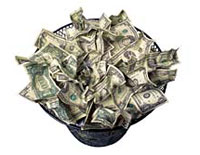Feds may cut interest rate up to 3.5 percent
In his Investment Outlook piece for Pacific Investment Management Co. [PIMCO]'s November newsletter, bond guru Bill Gross forecasts that the Fed will cut short-term interest rates to 3.5%.

"An increasingly recessionary looking U.S. economy will likely require 1% real short rates and 3.5% fed funds in order to stabilize a potential growth contraction in lending not witnessed since the early 1970s," he writes.
A few weeks ago, Gross said he expects the Fed to cut rates to 3.75% over the next 6-9 months. Bloomberg notes that futures traded on the Chicago Board of Trade put the odds of the Fed's lowering rates to 4.5% at its October 30-31 meeting at 98%.
The odds of a rate cut to 4.25% at the Dec. 11 meeting are 69%. In the newsletter, Gross expresses skepticism about Treasury Secretary Henry Paulson's "Super-SIV" -- a consortium of banks that plans to buy at-risk securities to prevent their prices from going into freefall, seekingalpha.com reports.
"Whether Paulson’s 'Committee to Save the World – Part II' will succeed like Bob Rubin’s original during the Long Term Capital crisis is debatable," he writes. "The idea...is counterproductive because it continues to hide subprime asset prices in the 'shadows.'"
Pravda.Ru has asked Andrew Jakabovics, Associate Director Economic Mobility Program, to comment on the present-day situation in US economy and with interest rates.
“The cut in the federal fund rate is likely to help the segment of American homeowners who have adjustable rate mortgages (ARMs) that are indexed to treasuries or to the Prime rate. Americans who are most at risk of losing their homes to foreclosure, however, are those borrowers with subprime ARMs.
Three-quarters of those borrowers have loans that are indexed to the London Interbank Offered Rate (LIBOR), which is higher today than a month or a year ago, are unaffected by the Fed's actions. While there may be some loosening of the credit crunch and increased liquidity for banks and other investors holding mortgages, it is by no means clear that the rate cut will translate into new mortgage lending activity.
Without a willingness to make new loans, the backlog in unsold houses continues to grow. The overall slowdown in housing markets across the country has wider impacts for the economy as a whole, as we have seen a dramatic cutback in new residential construction (down nearly 20 percent this August versus last August) that is likely to continue for some time.
Historically, we have used the housing sector to restart economic growth during slowdowns, but the Fed rate cut is unlikely to be that catalyst. Instead, we need a focused intervention by the White House and Congress to strengthen the housing market, secondary mortgage markets, and, ultimately, the economy as a whole,” says Andrew Jakabovics.
Source: agencies
Prepared by Alexander Timoshik
Pravda.Ru
Subscribe to Pravda.Ru Telegram channel, Facebook, RSS!


